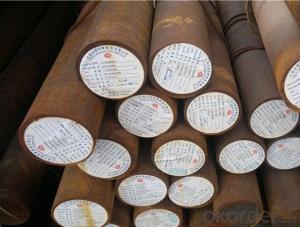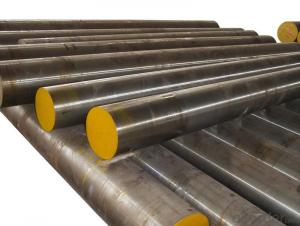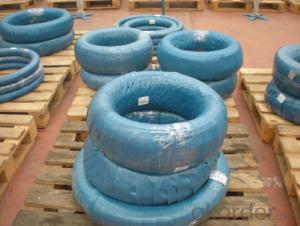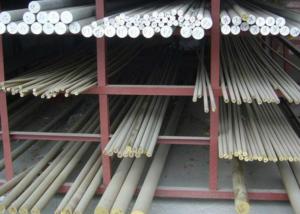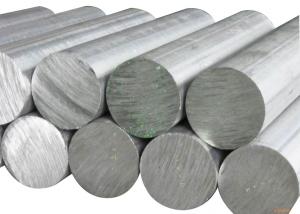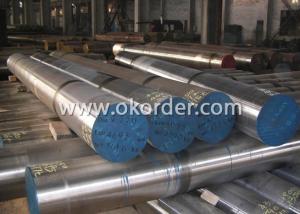Alloy Round Bar 51CrV4/6150/SUP10/50CrVA
- Loading Port:
- China main port
- Payment Terms:
- TT OR LC
- Min Order Qty:
- 30 m.t.
- Supply Capability:
- 10000 m.t./month
OKorder Service Pledge
OKorder Financial Service
You Might Also Like
Item specifice
Alloy Round Bar 51CrV4/6150/SUP10/50CrVA
Product Information:
Technique:Forged/Hot rolled/Cold draw/ESR/Grind-ed
Special use:Mold steel
Standard:AISI/ASTM/BS/DIN/GB/JIS
Surface:Black/Sanded/Turned/Peeled/Milled
Application:For military or aviation use
Dimensions:(Alloy round bars)Diameter12-350mm
Dimensions:(Square billets)H=100-400mm,B=100-550mm
Alloy or not:Is alloy
Certification:ISO9001
Quality inspection:UT,Chemical composition,Physical properties
Product Overviews:
| Product Name | Typical Grades | Diameter(mm) | Standard adopted |
| Carbon Steel | 20 (1020/S20C/C22) | Ø16-Ø300 | GB/SAE/JIS/DIN |
| 40 (1040/S40C/C40) | |||
| 45 (1045/S45C/C45) | |||
| Bearing Steel | GCr9 (51100/SUJ1) | Ø12-Ø250 | |
| GCr15 (52100/SUJ2/100Gr6) | |||
| GCr9SiMn (A485-Gr.1/SUJ3) | |||
| Cr-Mo Steel | 20Cr (5120/SCr420H/20Cr4) | Ø12-Ø250 | |
| 40Cr (5140/SCr440/41Cr4) | |||
| 42CrMo(4140/SCM440/42CrMo4) | |||
| Gear Steel | 20CrNiMo | Ø16-Ø600 | |
| 20CrMn(5115/SMnC420/20MnCr5) | |||
| 20CrNiMo(8620/SNCM220/20CrMiMo2) |
Product Show:
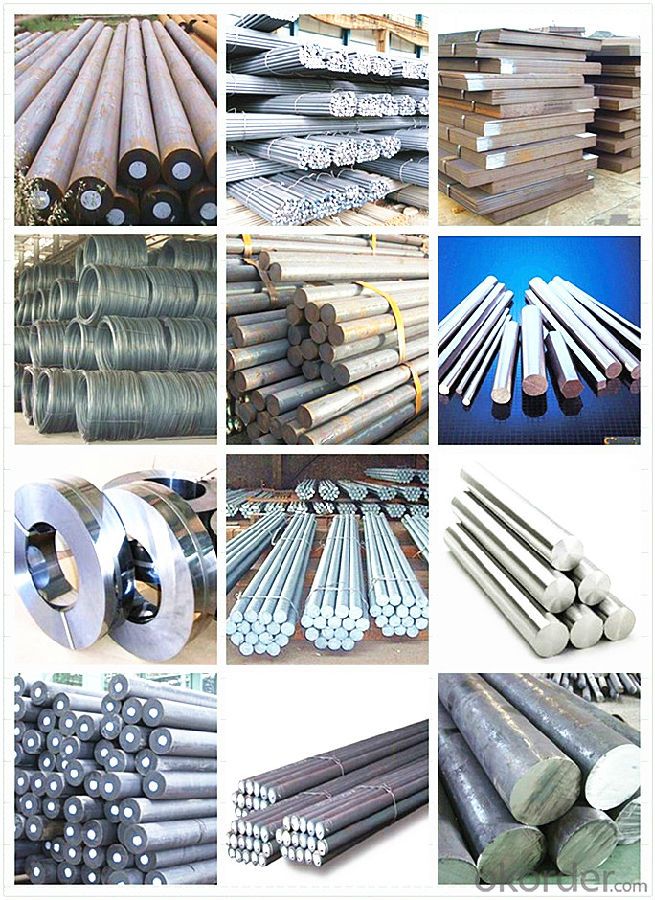
Our Advantages:
· Industry experience over 20 years.
· Shipment of goods -More than 70 countries worldwide.
· The most convenient transport and prompt delivery.
· Competitive price with best service.
· High technical production line with top quality products.
· High reputation based on best quality products.
With our experienced, enthusiastic and dynamic staffs, we assure to bring you the products with best quality, reasonable prices and good after-sales services under the motto: Friends First, Business After.
Communication, Experience, Expertise and Best efforts are our Promises to you.
- Q:What are the advantages of using special steel in manufacturing?
- Special steel in manufacturing offers several advantages. Firstly, it provides a higher level of strength and durability compared to regular steel. This is because of the presence of alloying elements, like chromium, nickel, and manganese, which enhance its mechanical properties. As a result, special steel can withstand heavy loads, resist wear and tear, and endure extreme conditions, making it ideal for manufacturing applications requiring strength and longevity. Secondly, special steel exhibits excellent corrosion resistance. The addition of elements like chromium forms a protective oxide layer on the steel's surface, preventing rusting and corrosion when exposed to moisture or harsh environments. This corrosion resistance is crucial in industries such as marine, automotive, and construction, where materials face constant exposure to water, salt, and chemicals. Furthermore, special steel possesses exceptional heat resistance and heat transfer properties. These properties are vital in manufacturing processes involving high temperatures, such as forging, casting, and heat treatment. Special steel retains its strength and structural integrity even at elevated temperatures, enabling the production of components capable of withstanding extreme heat conditions. Another advantage of using special steel in manufacturing is its versatility. It can be easily customized and tailored to specific requirements. Manufacturers can modify it to exhibit various mechanical properties, including hardness, toughness, or flexibility, depending on the application. This flexibility allows for the development of components with precise characteristics, ensuring optimal performance and efficiency. Lastly, special steel proves to be more cost-effective in the long run. Although initial costs may be higher than regular steel, its superior durability and longevity result in reduced maintenance and replacement costs. Additionally, the enhanced properties of special steel can lead to improved energy efficiency and reduced material waste, contributing to overall cost savings in the manufacturing process. In conclusion, the utilization of special steel in manufacturing brings forth benefits such as increased strength and durability, excellent corrosion resistance, superior heat resistance, versatility, and long-term cost-effectiveness. These advantages make it the preferred choice for various industries, guaranteeing the production of high-quality and reliable components.
- Q:What are the properties of wear-resistant stainless steel?
- Wear-resistant stainless steel has several properties that make it highly effective in resisting wear and tear. Firstly, it has a high hardness level, which allows it to withstand abrasive forces and maintain its shape under heavy loads. Additionally, it exhibits excellent corrosion resistance, preventing rust or degradation even in harsh environments. This type of stainless steel also possesses good impact resistance, meaning it can withstand sudden impacts without cracking or breaking. Furthermore, wear-resistant stainless steel typically has a low coefficient of friction, reducing frictional forces and minimizing wear when in contact with other materials. Overall, these properties make wear-resistant stainless steel a durable and reliable choice for applications where wear and tear are major concerns.
- Q:What are the applications of special steel in the aerospace sector?
- Special steel has various applications in the aerospace sector due to its exceptional properties. It is used for manufacturing critical components such as turbine blades, landing gear, and structural parts. The high strength, corrosion resistance, and heat resistance of special steel make it ideal for withstanding extreme conditions experienced during flight. Additionally, its lightweight nature contributes to fuel efficiency and overall performance improvement in aircraft.
- Q:What are the different methods of surface honing for special steel?
- There are several different methods of surface honing for special steel, each with its own advantages and applications. Some of the most commonly used methods include: 1. Manual Honing: This method involves using hand-held honing tools such as stones, sticks, or abrasive pads to manually remove material from the surface of the special steel. Manual honing allows for precise control and is often used for smaller or intricate parts. 2. Machine Honing: Machine honing utilizes specialized honing machines that automate the honing process. These machines typically consist of rotating honing stones or abrasive belts that remove material from the surface of the steel. Machine honing is often preferred for larger or more complex parts, as it can achieve consistent and high-quality results. 3. Diamond Honing: Diamond honing is a method that uses diamond abrasives to remove material from the surface of the special steel. Diamond is one of the hardest substances known, making it highly effective for honing steel. This method is often used for high-precision applications or when a very smooth surface finish is required. 4. Superfinishing: Superfinishing is a specialized honing process that is used to achieve extremely fine surface finishes on special steel. It involves using a combination of honing stones and abrasive pastes to remove microscopically small amounts of material from the surface. Superfinishing is typically used for critical applications where surface roughness and dimensional accuracy are of utmost importance. 5. Lapping: Lapping is a honing method that uses a combination of abrasive particles and a rotating or vibrating tool to remove material from the surface of the steel. It is often used for parts that require a very flat or parallel surface, such as bearings or sealing surfaces. 6. Electrochemical Honing: Electrochemical honing is a specialized honing process that uses an electric current to remove material from the surface of the special steel. It is often used for complex or hard-to-reach surfaces, as it can effectively remove material from areas that are difficult to access with other honing methods. In summary, the different methods of surface honing for special steel include manual honing, machine honing, diamond honing, superfinishing, lapping, and electrochemical honing. Each method has its own unique advantages and applications, allowing for precise control and achieving the desired surface finish and dimensional accuracy for special steel components.
- Q:What are the different welding methods used for special steel?
- There exists a range of welding methods that can be utilized for special steel, contingent upon the specific needs of the project. Some of the commonly employed welding methods for special steel comprise the following: 1. Gas Metal Arc Welding (GMAW): Also known as MIG welding, this technique employs a consumable electrode and a shielding gas to safeguard the weld against atmospheric contamination. GMAW is advantageous for welding special steel due to its ability to produce high-quality welds with minimal spatter. 2. Gas Tungsten Arc Welding (GTAW): Also known as TIG welding, this method employs a non-consumable tungsten electrode and a shielding gas to protect the weld. GTAW is frequently employed for special steel as it allows for precise control during the welding process, resulting in defect-free, high-quality welds. 3. Shielded Metal Arc Welding (SMAW): Also known as stick welding, this technique utilizes a consumable electrode coated in flux to shield the weld. SMAW is widely employed for special steel due to its versatility and portability, making it suitable for various positions and environments. 4. Flux-cored Arc Welding (FCAW): This method employs a tubular electrode filled with flux to safeguard the weld. FCAW is often utilized for special steel due to its ability to achieve high deposition rates and deep penetration, making it suitable for thicker materials. 5. Submerged Arc Welding (SAW): This technique employs a continuously fed wire electrode and a granular flux applied around the weld. SAW is commonly used for special steel as it can produce high-quality welds in thick sections. It is crucial to consider various factors, such as the type and thickness of the steel, the desired weld quality, and the specific application requirements, when selecting the appropriate welding method for special steel. Therefore, it is advisable to consult with welding professionals or engineers to determine the most suitable method for a particular project involving special steel.
- Q:What are the main applications of special steel in the chemical industry?
- Special steel is widely used in the chemical industry due to its excellent properties such as corrosion resistance, high temperature resistance, and strength. It is primarily used in the construction of chemical processing equipment, including reactors, pipes, valves, and storage tanks. Special steel ensures the safe and efficient handling of corrosive chemicals, as well as the prevention of leaks and contamination. Additionally, it is utilized in the production of catalysts, which play a crucial role in various chemical reactions. Overall, special steel enables the chemical industry to maintain high product quality, operational efficiency, and safety standards.
- Q:How does special steel perform in high-temperature creep?
- Special steel is specifically designed to perform well in high-temperature creep conditions. It possesses superior strength, resistance to deformation, and stability at elevated temperatures, making it highly suitable for applications where prolonged exposure to high temperatures and constant stress is expected. Its unique composition and heat treatment processes enable it to maintain its mechanical properties and resist deformation or failure for extended periods under these extreme conditions.
- Q:What are the different types of precipitation-hardening steel?
- There are several different types of precipitation-hardening steel, including 17-4 PH, 15-5 PH, 13-8 PH, and 17-7 PH. These alloys are known for their ability to be strengthened through a precipitation hardening process, which involves a combination of heat treatment and aging. Each type of precipitation-hardening steel has its own unique composition and properties, making them suitable for various applications in industries such as aerospace, automotive, and medical.
- Q:How does special steel perform in corrosion fatigue conditions?
- Special steel performs well in corrosion fatigue conditions due to its high resistance to corrosion and fatigue. It is specifically designed to withstand harsh environments and prolonged exposure to corrosive elements. Special steel undergoes various treatments and alloying processes to enhance its corrosion resistance and mechanical properties. This allows it to maintain its structural integrity and performance even under corrosive and fatigue-inducing conditions.
- Q:What are the main alloying elements used in special steel?
- The main alloying elements used in special steel can vary depending on the specific type of special steel, but common alloying elements include chromium, nickel, molybdenum, vanadium, and tungsten. These elements are added to enhance the steel's properties such as corrosion resistance, strength, hardness, and heat resistance.
1. Manufacturer Overview |
|
|---|---|
| Location | |
| Year Established | |
| Annual Output Value | |
| Main Markets | |
| Company Certifications | |
2. Manufacturer Certificates |
|
|---|---|
| a) Certification Name | |
| Range | |
| Reference | |
| Validity Period | |
3. Manufacturer Capability |
|
|---|---|
| a)Trade Capacity | |
| Nearest Port | |
| Export Percentage | |
| No.of Employees in Trade Department | |
| Language Spoken: | |
| b)Factory Information | |
| Factory Size: | |
| No. of Production Lines | |
| Contract Manufacturing | |
| Product Price Range | |
Send your message to us
Alloy Round Bar 51CrV4/6150/SUP10/50CrVA
- Loading Port:
- China main port
- Payment Terms:
- TT OR LC
- Min Order Qty:
- 30 m.t.
- Supply Capability:
- 10000 m.t./month
OKorder Service Pledge
OKorder Financial Service
Similar products
New products
Hot products
Related keywords
